
Transcription
Universal Life Church
Headquarters 601 Third Street, Modesto, California 95351
Telephone: (209)527-8111 E-mail: ulchq@aol.com Web: www.ulchq.com
Credentials of Ministry
This is to certify that the bearer hereof was ordained
this date: July 21, 1998
Name William Goehler
Address P.O.W. 409040 #K77832
City Ione, CA 95640
[Signature]
Lida G. Hensley, D.D., President
August 10, 2021
Re: August 9 ULC - "rehabilitate SOCIAL CONSCIOUSNESS"
What is social consciousness and why does it need to be rehabilitated? If society convicted an individual as unworthy of that society, that in itself affects the individuals Conditions of Existence① (BE-DO-HAVE). And then they are thrown into a penal colony environment as the Effect of Justice ~ deservedly or not. Here an individuals conditions of existence is drastically limited. There's a prevailing GroupThink② phenom which favors the worst in man in prison, enticing others to conform to criminal thinking. This prevailing culture of complicity often becomes the Social Consciousness of individuals who've been overwhelmed by their environment. This is true of any culture where individuals are convinced to conform by domination③ tactics. Alas, the DOC recidivism rate (over 80%) indicates the prison culture has fostered the worst in man ~ and that worst is defacto the social consciousness trapped in DOC's revolving door.
Until the sinister Psych Industry seized the opportunity to infiltrate and supplant the police-state paradigm. Now, that "worst" is excused with sympathy. Consequently, there's a certain loyalty in this symbiotic relationship where mental health [sic] professionals reform criminals to be mental health [sic] patients, more or less obliged to adopt sympathy computations justifying their low-toned conditions of existence - which conveniently provides job security to psych industry proponents.
How is it possible to rehabilitate this subverted Condition of Existence? If readers of this blog would go to scientologyhandbook.org, or even the http://course.volunteerministers.org, and study THE EMOTIONAL TONE SCALE, you may better understand the ETHICS AND CONDITIONS lesson as well. Observing the TONE SCALE ON Hubbard's Chart of Human Evaluation will help you locate an individual on its columns - Column 5 for instance will designate "Command Over Environment", while in Column 6 designates "Actual Worth to Society - Compared to Apparent Worth", and these of course correlate to column 7 "Ethical Level", and the other 21 columns as well. L. Ron Hubbard wrote, "If one lives in a low-toned environment
[Page 2]
he can expect, eventually, to be low-toned. This is also true of marriage - one tends to match the tone level of one's marital partner. This ToneScale is also valid for groups. A business or a nation can be examined as to its various standard reactions and these can be plotted [on the Chart of Human Evaluation]. This will give the survival potential of a business or a nation. This chart can also be used in employing people or in choosing partners. It is an accurate index of what to expect and gives you a chance to predict what people will do before you have any great experience with them. Also, it gives you some clue as to what can happen to you in certain environments or around certain people, for they can drag you down or boost you high."④
Now, remember what I said about sympathy computations justifying low-toned conditions of existence? A psych patients social consciousness is established with sympathy - accepting irresponsibility. The question is how to help reverse that dwindling spiral⑤ phenomena and rather develop a prisoners responsibility to improve conditions.
Social consciousness is fostered by authority figures and corresponding association of peers, apparently. What opportunities do you think are available to help develop social consciousness in prison? Oppressive prison regulations and/or dominating criminals; don't appeal to overwhelmed prisoners, as well as liberating psych's. Academic-Vocational-Religious education expand perception of dimensions and corresponding associations with higher-toned individuals - in the most part. But social consciousness remains limited within the sphere of prison, and not particularly with society at large.
Social Consciousness - for me - has been developed through education (both religious and academic), where authority figures and peers acknowledged my profound interest and effort to excell. Their cooperation permitted my social consciousness to expand and impact my zone of influence. Having an acute understanding of ETHICS AND THE CONDITIONS (see: scientologyhandbook.org, or http://course.volunteerminister.org), I'm able to expect better conditions by following appropriate formulas ~ while conversely understanding the barriers imposed within a prevailing culture of complicity.
In the ETHICS AND THE CONDITIONS course, for instance, the formula to get out of non-existence is as simple as: 1-Find a communication line. 2-Make yourself known. 3-Discover what is needed or wanted. 4-Do, produce and/or present it. Below non-existence, there's a Condition of Liability, where an individual has taken on the social character of a potential enemy. Such a person cannot be trusted. It is a liability to have such a person unwatched - as they may do or continue to
[Page 3]
do things to stop or impede the forward progress of things. For a person in this condition to rise, they must follow the formula of libaility: 1 - Decide who are one's friends. 2- Deliver an effective blow to the enemies of the group one has pretended to be part of - despite personal danger. 3- Make up the damage one has done by personal contribution far beyond the ordinary demands of a group member. 4- Apply for reentry to the group by asking permission of each member of it to rejoin - and rejoining only by majority permission, and if refused, repeating (2) and (3) and (4) until one is allowed to be a group member again. Where upon the formula of Non-existence ushers in the expanded non-existence formula... which appears much like the Emergency Condition formmula.
In any event, I've proven to be interested in rejoining society and I've certainly "contributed far beyond the ordinary demands" in chosing to help ennoble others in my zone of influence. I'm determined to help restore purpose, truth and spiritual values to the lives of others ~ whether that's done here in prison, or here on my blog site. I instigate thought, with a clear understanding that Thinking and Doing and closely interrelated in the noosphere (look it up). Wouldn't that ultimately serve to deliver a higher social consciousness - from right here in my penal colony environment? Can I please see comments here granting permission to rejoin society, per the above formula? I think that 25 years in exile permitted me sufficient time to study how I can help improve conditions in my ever expanding zone of influence. I've got plenty of ideas on how to improve conditions out there as well. Can I please see comments here granting your permission for me to join your society out there? Thank you.
And with that said, I'm reminded that I have to re-propose my recycling proposal (see: betweenthebars.org/posts/30102/recycling), along with reminding PowersThatBe, that I can also facilitate self-help groups.
For the love of Truth
William Goehler
SPO-VM-ULC
①CONDITIONS OF EXISTENCE, there are three conditions of existence. These three conditions compromise life. They are BE, DO and HAVE. The condition of being is defined as the assumption (choosing) of a category of identity. An example of beingness could be one's own name. Another example would be one's profession. The second condition of existence is doing. By doing, we mean action, function, accomplishment, the attainment of goals, the fulfilling of purpose, or any change of position in space. The third condition is havingness. By havingness we mean owning, possessing, being capable of commanding, positioning, taking charge of
[Page 4]
objects, energies or spaces. These three conditions are given in an order of seniority (importance) where life is concerned.
②GROUPTHINK, the common denominator of the group is the reactive bank [i.e. the unconscious mind]. Thetans [Spirit- the being who is the individual who handles and lives in the body] without banks have different responses. They only have their bands in common. They agree then only on bank principles. Person to person the bank is identical. So constructive ideas are individual and seldom get broad agreement in a human group.
③DOMINATION, forcing the other person to do exactly what is desired with the mechanism of recrimination and denial of friendship or support unless instant compliance takes place. It seeks by anger and outright criticism, accusations, and other mechanisms to pound another individual into submission by making him less.
④Scientologyhandbook.org - THE EMOTIONAL TONE SCALE
⑤DWINDLINGSPIRAL, 1. one commits overts*acts unwittingly. He seeks to justify them by finding fault or displacing blame. This leads him into further overts against the same terminals which leads to a degradation of himself and sometimes those terminals. OVERTACTS, is not just injuring someone or something, an overt act is an act of omission or commission which does the least good for the least number of dynamics or the most harm to the greatest number of dynamics. 2. an intentionally committed harmful act committed in an effort to resolve a problem. 3. that thing which you do which you aren't willing to have happen to you.
①,②,③,⑤; DIANETICS AND SCIENTOLOGY TECHNICAL DICTIONARY, by L. Ron Hubbard (1975-1989) BRIDGE PUBLICATIONS
To understand Social Consciousness better, you may study the differences between THE ANTISOCIAL PERSONALITY attributes, and THE SOCIAL PERSONALITY attributes @ scientologyhandbook.org and/or http://course.volunteerministers.org. titled: THE CAUSE OF SUPPRESSIONS.
[Page 5]
BTB
Dear Goehler,
I hope this newsletter has useful information for you.
Best,
Dale
ELLA BAKER CENTER for HUMAN RIGHTS
She led. So can you.
June 28, 2021
Dear Friend,
Daniella, Kierra, and Georgia here - writing to you as the Ella Baker Center for Human Rights (EBC) summer policy interns! We wanted to send you our second 2021 legislative newsletter in an effort to update you on our policy campaigns and organizing work, as well as the latest on pending laws that affect sentencing and incarceration in California. We hope the information we've included here is helpful for you in your personal advocacy efforts as well as for other people in your life who could benefit from this newsletter.
Please know that during the last year, EBC's mailing list has tripled in size! This means that our community is stronger than ever, and it also means that it may take us longer to respond to your letters. We apologize if you wrote and we didn't reply to you yet. We are doing our best and will try to be in touch as soon as possible! Please help us in getting useful information shared and keep us in the loop about what you're experiencing and your ideas and feedback.
About the Ella Baker Center for Human Rights:
We are named after the brilliant, Black hero of the civil rights movement who inspired and guided emerging leaders. We exemplify Ella Baker's legacy by building the power of Black, brown, and poor people, shifting resources away from prisons and punishment and towards opportunities that make our communities safe, healthy, and strong.
Currently our organization works to end criminalization and mass incarceration in the United States. We have been leading work to respond to the COVID-19 outbreaks at Santa Rita Jail (through Decarcerate Alameda County), San Quentin State Prison (through the #StopSanQuentinOutbreak coalition) and across California state prisons, jails and ICE detention centers by advocating to stop involuntary transfers, expand releases without categorical exclusions, protect the health and safety of incarcerated people, and provide accurate information to people inside and to their families.
Below you will find an update on the legislation that we are co-sponsoring for the 2021 legislative cycle, along with some of the important legislation that our allies are leading in 2021-2022.
2021 Legislation Co-Sponsored by the Ella Baker Center
These EBC co-sponsored bills made it through their "first house," the legislative house of origin. They are now moving on to their second legislative house, and then on to the Governor's desk.
AB 256 California Racial Justice Act for All (Asm. Kalra) - asserts civil rights in the courtroom: explicitly prohibiting the state from discriminating on the basis of race, ethnicity, or national origin to seek or obtain a conviction or sentence. The Act would allow the RJA's protections to apply retroactively to include prior convictions where racism was a factor for anyone currently incarcerated who is convicted of a felony and for people facing deportation. Beginning in 2023, AB 256 will also allow formerly incarcerated people with felony convictions dating back up to 10 years to file a motion for relief. By 2025, AB 256 will apply to any felony conviction ever.
[Page 6]
AB 292 Access to Programming Act (Asm. Stone) - reduces barriers to programming, like interruptions due to transfers, quarantines, lockdowns and conflicting work assignments. In addition, this bill establishes a pathway for people serving convictions for either nonviolent or violent offenses to earn the same amount of good conduct credits once their VIO administrative determinant is removed.
SB 483 Repeal Ineffective Sentence Enhancements (RISE) Act (Sen. Allen) - will reduce prison and jail populations, by retroactively applying the elimination of the three-year (SB 180, 2017) and CDCR and Sheriffs to identify folks with these enhancements and provide their information to resentencing courts by July 1st, 2022 for individuals who have served their base term and are currently serving a sentence based on an enhancement and by December 31, 2023 for all other individuals.
The following bill is now a 2-year bill. It will be on the inactive file until the beginning of Jan. 2022.
SB 300 Sentencing Reform Act of 2021 (Sen. Cortese) - will reform CAs unjust "felony murder special circumstance" law. It would ensure that the death penalty and life without the possibility of parole would not be imposed on these who did not kill a person, or who as an accomplice to a felony did not intend that person die. It will restore judge's discretion to strike the 'special circumstances' enhancement, and provide for resentencing of persons currently in prison with LWOP or death sentence.
Bills to Watch in 2021 (Second House)
These bills were introduced in 2021 and are now entering their second legislative house.
AB 124 (Asm. Kamlager) Second Look 1170(d) Resentencing Act requires the court to consider intimate partner violence and other traumatic experiences as contributing factors in sentencing and resentencing decisions. If the trauma of those experiences affected the defendant's crime of conviction, it would require the court to sentence them to the lowest possible sentence. Lastly, this legislation would allow currently incarcerated people to refer themselves for resentencing.
AB 503 (Asm. Stone) Expanding the California Identification Program will allow all people released from the custody of CDCR to have a chance to receive legal photo identification before their reentry into society. Amended such that people being released who didn't have a Cal ID card or driver's license before release will receive a Cal ID card, while people who already had a driver's license will be offered a duplicate or renewal driver's license.
AB 937 (Asm. Carrillo) VISION Act will prohibit any state or local agency from arresting or facilitating the arrest or transfer to ICE detention centers. It would also end the CDCR's mandate to
[Page 7]
SB 775 (Sen. Baker) Expansion of SB 1437 Limit on Felony Murder will permit people convicted via the Felony Murder rule to petition for resentencing or appeal if they were prosecuted for murder, attempted murder, or voluntary manslaughter. Folks can petition for resentencing (or challenge on direct appeal) if they were prosecuted under the natural and probate consequences doctrine or the theory where malice is imputed to a person based solely on their participation in a crime.
SB 81 (Sen. Skinner) Make the Crime Match the Time aims to provide guidance on when judges may apply sentence enhancements by clarifying the parameters a judge must follow to improve fairness in sentencing and help ensure that penalties more closely reflect the circumstances of the crime. SB 81 establishes a presumption that judges should not apply enhancements unless there is clear and convincing evidence that not using the enhancement would endanger the public.
ACA 3 (Sen. Kamlager) Involuntary Solitude will amend the California Constitution to remove the conditional language that states slavery and involuntary servitude is prohibited "except to punish crime." This would thereby abolish slavery and involuntary servitude without exception.
Bills that Stalled
These are now 2-year bills. They will be on the inactive file until the beginning of January 2022.
AB 329 - The Pretrial Justice Reform Act creates a more fair pretrial system by ensuring people accused do not remain in custody simply because they cannot afford bail. The bill was set bail at $0 for most misdemeanors and low-level felonies.
AB 679 (Asm. Friedman) Testimony of In-Custody Informants will make testimony or information obtained by an in-custody informant inadmissible in a felony prosecution if the informant's testimony or the information was obtained in exchange for a grant or promise by an attorney representing the state. The bill would also expand the definition of "in-custody information" to include when the informant and the suspect/defendant are in custody of law enforcement, in any custodial setting.
AB 960 (Asm. Ting) Expand Medical Parole would create a medical parole panel, composed of a department psychologist, a primary care provider, and a representative from California Correctional Health Care Services, at each institution to act as the state's parole authority for the purpose of medical parole decisions. The bill would expand the qualifying criteria for medical parole, establish a new medical parole consideration process, and remove the department's authority to return an individual to custody.
SB 481 (Sen. Durazo) Sentencing: Special Circumstances will allow people serving a sentence of life without the possibility of parole for an offense that was committed when they were under 25 years of age to petition the court to recall and resentence them to a lesser sentence. This would include people with a conviction that includes torture or in which the victim was a public safety official, including a firefighter or police officer. This bill creates a youth offender parole hearing for the purpose of reviewing the parole suitability of any person under 25 years of age at the time of the alleged offense.
Bills that Died in 2021
These bills died either in committee or on the floor. They can be taken up again in the future, but will need to start the process over again.
[Page 8]
implement procedures to identify all undocumented, incarcerated people in their custody and restricts local and state governments from sharing immigrant status information.
AB 990 (Asm. Santiago) Keeping Families Connected seeks to strengthen visiting rights in California's state prisons by making them a civil right. The bill was amended to focus on removing specific barriers to visiting by prohibiting denials of visiting based on: a rule violation that did not occur during visiting with the affected visitor; errors or omissions on a visiting application if the information is in the applicant's DOJ criminal background report; and the visitor's or incarcerated person's contact history with law enforcement except for serious violations of visiting rules.
AB 1540 (Asm. Ting) Ensuring Due Process & Equity in CA Resentencing Laws seeks to address implementation issues of Penal Code section 1170(d)(1) by ensuring that an incarcerated person receives notice of their resentencing referral; creating court deadlines and the right to counsel; providing a presumption in favor of resentencing for all law enforcement referrals; and clarifying that a judge can reduce a charge to a lesser-included or lesser-related offense. The bill will also give the Attorney General the power to recommend a person for resentencing when they prosecuted the case, and make PC § 1170(d)(1) its own Penal Code section to clarify the law.
SB 73 (Sen. Wiener) Repealing Mandatory Jail Sentences for Nonviolent Drug Offenses will repeal mandatory minimum sentences for persons convicted of specified nonviolent drug offenses and provides judges with the discretion to grant probation.
SB 317 (Sen. Stern) Credit for Placement in Mental Hospital will permit application of conduct credits for persons confined in a state hospital or other mental health treatment facility pending their return of mental competency.
SB 383 (Sen. Cortese) The Juvenile Justice Diversion Act seeks to expand opportunities for youth who commit nonviolent felonies by increasing access to diversion programs. This includes giving access to youth that may have sold, possessed, or distributed controlled substances.
SB 416 (Sen. Hueso) Incarcerated Students' Bill of Rights Act will provide incarcerated students protections while they seek post-secondary education by protecting access to face-to-face classroom-based instruction or distance-learning courses that meet the entrance standards. The bill would also give incarcerated students who are enrolled in full-time college programs the option to be classified as a college student.
SB 731 (Sen. Durazo) Sunset of Criminal Convictions will create a comprehensive process to automatically seal conviction and arrest records in California once a person has fully completed their sentence and successfully gone two years without law enforcement contact. Records of arrests that didn't result in a conviction would also be automatically sealed.
AB 333 (Asm. Kamlager) STEP Forward Act will limit the use of gang enhancements by narrowing the scope of what is considered a "criminal gang" and what are defined as "criminal gang activities." Namely, it would remove burglary, looting, felony vandalism, and specified personal identity fraud violations from the crimes that defines a pattern of criminal gang activity.
AB 518 (Asm. Wicks) Violations Punishable in Different Ways will end the requirement that a person be punished under the law with the longest possible term of imprisonment possible.
[Page 9]
AB 1224 (Asm. Levine) Restore power to dismiss special circumstances would have restored the power of judges to dismiss special circumstances after a jury verdict and goes further by requiring dismissal in many circumstances, including if it has been more than 20 years since the conviction and the individual has not committed any violent acts since.
AB 1509 (Asm. Lee) Anti-Racism Sentencing Reform Act would have eliminated most gun enhancements and reduced all others to 1/2/3 years while allowing for retroactive relief.
SB 243 (Sen. Wiener) End Wrongful Convictions Act would have expanded the definition for false forensic science in habeas law to give convicted persons a more just shot at relief when the court finds that the forensic science was not evidence-based or if there has been the emergence of a dispute in the relevant scientific community and the evidence is no longer reliable.
SB 493 (Sen. Bradford) The PROMYSE (Promoting Youth Success and Empowerment) Act would have required at least 95% of Juvenile Justice Crime Prevention Act (JJCPA) funds to be invested in community-based organizations for trauma-informed and youth development work.
We will know more about the status of these bills over the coming weeks and months. We are currently gathering ideas for our 2022 policy agenda so please send those our way. In the meantime, we and the rest of the Ella Baker Center will be advocating, organizing, and spreading the word and we ask you to join us.
#StopSanQuentinOutbreak Coalition
In addition to our policy advocacy efforts, EBC has also been supporting organizing efforts of the #StopSanQuentinOutbreak coalition, which can together in June 2020 to amplify the demands of our currently incarcerated community members at San Quentin during the height of the COVID outbreak. We continue to call for large-scale releases across California state prisons, jails, and ICE detention centers. In June, we released an online toolkit marking the one year anniversary of the transfer that led to the outbreak at San Quentin, featuring an illustrated timeline by Orlando Smith of the outbreak and organizing in response, and a short film about the coalition by Adamu Chan.
Thanks to everyone who built with us this year. It's an honor to fight for freedom with you.
In Solidarity
[Signature]
Daniela Castro
Summer Intern
[Signature]
Georgia Valentine
Summer Intern
[Signature]
Kierra Brown
Summer Intern
[Page 10]
ELLA BAKER CENTER for HUMAN RIGHTS
She led. So can you.
June 30th, 2021
Dear Friend,
As we navigate the uncertainty and adversity of the COVID-19 pandemic, we have been fighting for mass release and policy change to ensure the satefy of our community - particularly our incarcerated community. During the last year our mailing list tripled in size! This means that our community is stronger than ever, and that it may take us longer to respond to your letters. We apologize if you wrote and we didn't reply to you yet. We are doing our best and will try to be in touch as soon as possible.
New Credits Earning Percentages as of May 1, 2021
On May 1, 2021, new credit earning percentages went into effect for a number of people serving both determinate and indeterminate sentences for "nonviolent" and "violent" cases.
Violent: Previous Rate = 20% (1 day of credit for every 4 days served) New Rate (May 1, 2021) = 33.3% (1 day of credit for every 2 days served)
Nonviolent Second Striker: Previous Rate = 33.3%, New Rate (May 1, 2021) = 50% (1 day of credit for every 1 day served)
Nonviolent Third Striker: Previous Rate = 33.3%, New Rate (May 1, 2021) = 50% (1 day of credit for every 1 day served)
Here is a breakdown of the new Good Conduct Credits:
• All people with "nonviolent" cases who have Proposition 57 eligible 2nd strike and 3rd strike sentences will get 50% off their sentences
• People with "violent" cases will go from 20% to 33 1/3% off their sentence - except those with Death Penalty or LWOP sentences
• Everyone who is impacted by these new credits should get a new letter with their new parole eligibility or release date. CDCR is estimating it may take Case Records up to 8 months to calculate and enter everyone's new dates into a new computer system.
• The new credit earning rates are effective May 1, 2021 and will not be retroactive.
• The new credit earning rates are not being applied to "Youth Offender Parole Eligible Dates" or "Elderly Parole Eligible Parole Dates." People who have already been denied by the Parole Board will also not be affected by these new credit earning percentages.
• For people awaiting transfer from county jail to CDCR who have already been sentenced, they will receive the new credits percentage as of May 1, 2021
• In addition, new Minimum Security Credits (MSC) will be awarded to people in conversation camps: "Under the emergency regulations, CDCR is establishing the Minimum Security Credit (MSC), which will be awarded to all eligible incarcerated people who work in conservative (fire) camps, are trained as firefighters, or who are assigned to minimum custody status. Effective May 1, 2021, people will be awarded 30 days of credit for every 30 continuous days served."
1419 34th Avenue, Suite 202 • Oakland, CA 94601 ph 510.428.3939 fax 510.428.3940 www.ellabakercenter.org
[Page 11]
Effective June 1, 2021 Case Records issued a new procedure to be implemented causing a manual recalculation for all incarcerated people with a release date in the future. CDCR claims the old methodology was flawed for the following reasons:
• Good Conduct Credits (GCC) were being applied beyond the days the person would actually be in custody (giving credits for days not served in prison causing dates to move farther out)
• People that received a disciplinary action (CDCR 115) were not earning credit for the amount of days they lost even when not in a zero earning status (D2 or C status)(the new calculation fixes that and applies credit for the amount of days lost resulting in dates moving closer in as they were owed these past credits)
• Banked Milestone Completion Credits (MCC) were being calculated into the projected release date before it should have been
• Work Group F or M were projected into the calculated release date (this is giving too many credits due to the person not having served the days to apply it to)
• Effective May 1, 2021, all credits received (GCC, MCC, ECC, EMC, RAC and Disciplinary actions or CDC 115's) are now given or taken according to the credit earning of the incarcerated person. They are no longer whole day applications but calculated at either 33.3% or 50% of whatever the amount of time lost or time earned is. For example, if a person is earning 50% and gets a 100 day credit loss, only 50 days would be taken. The same is true of MCC's. If a person earning 50% earns 14 days, 7 days are applied. This is a manual calculation process and is worked on by the Correctional Case Records Analysts.
We are trying to better understand the range of the impact of these new credits calculations. If the new credit calculations have impacted you and added time to your sentence, please write to us and let us know what is happening in your case.
Update on Prison Closures
On April 13th 2021, CDCR announced that California Correctional Center (CCC) in Susanville will be deactivated by June 30, 2022. This deactivation is part of the Governor's plan to close two prisons (the first, Deuel Vocational Institution in Tracy, will deactivate by September 30, 2021). In addition to CCC, the secure Level 1 facilities at California Correctional Institution and Correctional Training Facility will close by June 30, 2022. Advocacy groups led by CURB continue to call for 10 CA prisons to close by 2025, based on their People's Plan for Prison Closure report which surveyed incarcerated members across CA.
COVID-19 Stimulus Payments
We have been receiving a lot of questions about the new stimulus that the U.S. Congress recently passed. Payments will be automatically made via the method used for the first stimulus payment. If you are preparing to file your 2020 tax return you cannot use the old EIP 2019 form. The IRS is now requiring people file a full 1040 form to receive these stimulus payments, even if they would not normally file taxes because they do not have income over $12,200 (or $24,400 if filing a joint return). We can send you sample and blank 1040 forms you can use if they have not already been passed out in your facility. While no debts or restitution (other than child support) could be taken from the first two stimulus payments, if you are still owed these two stimulus payments and are filing for them as a 2020 tax refund, then there are not currently protections against debt and restitution being taken from your stimulus payments. Governor Newsom also passed a California-specific "Golden State Stimulus" package, which will provide $600 for many Californians who file their 2020 tax return. However, currently incarcerated people are not included in the California stimulus package - unless you are in county pretrial and have not yet been convicted, or you are married, filing jointly and have a dependent child.
Updates from the CDCR and the Courts: On October 20th, there was a victory that incarcerated organizers at San Quentin (SQSP) and outside advocates had been fighting for throughout the COVID-19 pandemic: the First District Court of Appeal ruled that SQSP acted with deliberate indifference and that
1419 34th Avenue, Suite 202 • Oakland, CA 94601 ph 510.428.3939 fax 510.428.3940 www.ellabakercenter.org
[Page 12]
relief is warranted in order to prevent further illness and suffering as a result of the pandemic. The ruling directed SQSP to reduce the population to 1,775 people by either release or transfer. On December 23rd, the California Supreme Court issued a decision on the Court of Appeal's Von Staich decision, and ruled to send the case back down to the Court of Appeals. This means the previous order to reduce the SQSP population is now "vacated" (no longer exists). This decision is extremely disappointing. On February 24th, the Court of Appeals issued their second order in the Von Staich case - this time they have decided to send that case back to the Marin County Superior Court to hold an evidentiary hearing on the matter. On June 4th, testimony concluded in the evidentiary hearing for the group petitions for habeas corpus from SQSP. The opening brief for this case is scheduled for July 7th with a reply on August 18th. No dates were set for the final decision. We will continue to track this case and update this information. Attorneys are encouraging people at all prisons to file habeas petitions to show that the issue is not isolated to SQSP, but that conditions are cruel and unusual at every prison.
In February 2021, the Office of the Inspector General (OIG) released their third report in a COVID-19 Review Series. The report outlines how the California Correctional Health Care Services (CCHCS) and CDCR caused a public health disaster at SQSP when they transferred medically vulnerable incarcerated persons from the California Institution for Men (CIM) without taking proper safeguards. One of the most haunting findings established by this report is that CDCR and CCHCS deliberately pushed forward the transfer, fully aware of the deadly risks at hand and despite multiple objections and warnings from their own medical staff about the grave risk this created. The report notes that a CCHCS executive stated: "The benefit of a more rapid move in this specific situation appears to outweigh the risks." Advocates from the #StopSanQuentinOutbreak coalition continue to call for large-scale releases without exclusions to urgently decarcerate prisons to below 50% capacity as the only public health solution to COVID-19.
Expedited Release: In March 2020, CDCR released 3,500 people early to reduce crowding and in July started the COVID-19 Expedited Release program, which reviewed people for early release who have 1 year or less to serve on their sentence. Between July 1, 2020 and January 20, 2021, roughly 7,200 people were released early through the COVID-19 early-release programs. Between December 3, 2020 and January 13, 2021 - the 180-day release program resulted in 362 releases. That is a small number relative to the more than 1,700 "natural releases" that happened during that same time period. According to the Prison Law Office, of the approximately 6,200 people eligible for consideration of release under the "high-risk medical release" program Governor Newsom announced on July 10, 2020, roughly 3,900 have indeterminate terms, but only determinately sentenced people are being considered. Of the ~2,900 people in that cohort, ~1,100 were considered, and only 41 people were approved for release. CDCR has referred some people back to court for PC § 1170(d)(1) resentencing if they had a COVID medical risk score of 3 or higher, a determinate sentence, and a non-sexual case history. As of January 25, 2021, 15 were released and an additional 153 were referred to the courts for possible resentencing. As of March 12, 2021, the Governor granted medical reprieves of sentences to 10 additional individuals deemed high risk for COVID-19. These individuals range in age from 56 to 77 years old.
VACCINATIONS: COVID-19 vaccines that have been authorized by FDA have been carefully evaluated in clinical trials for their ability to protect us from COVID-19. CDC advises people to get the vaccine even if they have been sick with COVID-19 before. As of June 23rd, 65,626 incarcerated individuals have been fully vaccinated (69% of the current population), and 70,000 (72% of the population) have at least received their first-dose. 26,354(33%) of staff members have been fully vaccinated and 1,777 have received their first dose①. It is CDCR's intent to offer COVID-19 vaccinations to all CDCR and
① Staff vaccination rates are under-reported as they can also receive a vaccine from an outside health-care provider.
1419 34th Avenue, Suite 202 • Oakland, CA 94601 ph 510.428.3939 fax 510.428.3940 www.ellabakercenter.org
[Page 13]
CCHCS employees and incarcerated individuals. This includes: staff and residents at skilled-nursing facilities, frontline workers and correctional staff at other facilities, and vulnerable incarcerated people such as folks incarcerated in a Correctional Treatment Center (CTC) or Outpatient Housing Unit (OHU).
COVID DEATHS: We regret to share that there have been 227 people in CDCR who have died from the disease. See the following CDCR chart (From the CDCR website, June 30th, 2021) for confirmed COVID-19 cases and outcomes of individual institutions.
CDCR PATIENTS: CONFIRMED COVID-19 AND OUTCOMES
Institution | Institution Name | Confirmed | New in Last 14 Days | Active in Custody | Released While Active | Resolved | Deaths
CCC | CA Correctional Center | 1,395 | 13 | 13 | 33 | 1,349 | 0
NKSP| North Kenn State Prison | 937 | 7 | 7 | 10 | 916 | 4
MCSP| Mule Creek State Prison | 1,873 | 4 | 4 | 2 | 1,858 | 9
CHCF| California Health Care Facility | 633 | 2 | 3 | 2 | 611 | 17
DVI | Deuel Vocational Institution | 544 | 1 | 1 | 5 | 538 | 0
RJD | R.J. Donovan Corr. Fac. Rock Mtn. | 1,012 | 1 | 1 | 1 | 992 | 18
SOL | CA State Prison Solano | 1,243 | 0 | 1 | 11 | 1,225 | 6
VSP | Valley State Prison | 1,731 | 1 | 1 | 15 | 1,713 | 2
ASP | Avenal State Prison | 3,107 | 0 | 0 | 66 | 3,033 | 8
CAC | California City Correctional Facility | 999 | 0 | 0 | 9 | 988 | 2
CAL | Calipatria State Prison | 1,123 | 0 | 0 | 10 | 1,111 | 2
CCI | CA Correctional Institution | 1,383 | 0 | 0 | 63 | 1,316 | 4
CCWF| Central CA Women's Facility | 809 | 0 | 0 | 1 | 807 | 1
CEN | Centinela State Prison | 864 | 0 | 0 | 7 | 856 | 1
CIM | CA Institution for Men | 1,501 | 0 | 0 | 32 | 1,442 | 27
CIW | CA Institution for Women | 489 | 0 | 0 | 10 | 478 | 1
CMC | CA Mens Colony | 2,470 | 0 | 0 | 23 | 2,436 | 11
CMF | CA Medical Facility | 710 | 0 | 0 | 3 | 696 | 11
COR | CA State Prison Corcoran | 1,076 | 0 | 0 | 5 | 1,066 | 5
CRC | CA Rehabilitation Center | 1,993 | 0 | 0 | 58 | 1,934 | 1
State Total | 49,406 | 31 | 31 | 606 | 48,542 | 227
Date Last Updated Jun 30 2021 6:19AM
CDCR PATIENTS: CONFIRMED COVID-19 AND OUTCOMES
Institution | Institution Name | Confirmed | New in Last 14 Days | Active in Custody | Released While Active | Resolved | Deaths
CIW | CA Institution for Women | 489 | 0 | 0 | 10 | 478 | 1
CMC | CA Mens Colony | 2,470 | 0 | 0 | 23 | 2,436 | 11
CMF | CA Medical Facility | 710 | 0 | 0 | 3 | 696 | 11
COR | CA State Prison Corcoran | 1,076 | 0 | 0 | 5 | 1,066 | 5
CRC | CA Rehabilitation Center | 1,993 | 0 | 0 | 58 | 1,934 | 1
CTF | Correctional Training Facility | 2,719 | 0 | 0 | 29 | 2,671 | 19
CVSP| Chuckawalla Valley State Prison | 1,076 | 0 | 0 | 19 | 1,756 | 9
FSP | Folsom State Prison | 1,370 | 1 | 0 | 12 | 1,356 | 2
HDSP| High Desert State Prison | 2,032 | 0 | 0 | 6 | 2,024 | 2
ISP | Ironwood State Prison | 1,568 | 0 | 0 | 11 | 1,556 | 1
KVSP| Kern Valley State Prison | 895 | 0 | 0 | 7 | 882 | 6
LAC | CA State Prison, LA County | 1,511 | 0 | 0 | 10 | 1,488 | 13
PBSP| Pelican Bay State Prison | 222 | 0 | 0 | 5 | 217 | 0
PVSP| Pleasant Valley State Prison | 1,990 | 0 | 0 | 13 | 1,974 | 3
SAC | CA State Prison, Sacramento | 293 | 0 | 0 | 2 | 290 | 1
SATF| Substance Abuse Treatment Facility | 3,011 | 0 | 0 | 15 | 2,989 | 7
SCC | Sierra Conservation Center | 1,431 | 1 | 0 | 18 | 1,413 | 0
SQ | CA State Prison, San Quentin | 2,241 | 0 | 0 | 44 | 2,169 | 28
SVSP| Salinas Valley State Prison | 679 | 0 | 0 | 6 | 668 | 5
WSP | Wasco State Prison | 1,768 | 0 | 0 | 43 | 1,724 | 1
State Total | 49,406 | 31 | 31 | 606 | 48,524 | 227
1419 34th Avenue, Suite 202 • Oakland, CA 94601 ph 510.428.3939 fax 510.428.3940 www.ellabakercenter.org
[Page 14]
Free Phone Calls and Reduced Phone Call Costs: According to CDCR website "Global Tel Link (GTL) will offer 15 minutes of free calling every two weeks. The minutes do not to be used at the same time, but any unused minutes within the two-week period will not roll over and no credit is given. GTL and CDCR have signed a new 6-year contract with new, reduced phone rates. In-state and out-of-state calls with cost 2.5 cents per minute, a reduction of 5.1 cents per minute for local calls (same area code) and calls within California, and a reduction of 18.5 cents per minute for calls outside of California. This means a 15-minute call will now cost 37.5 cents anywhere in the US. International Calls will be 7 cents per minute, a reduction of 68 cents per minute. Moreover, every incarcerated person will be allotted 15 minutes of free phone calls and 15 minutes of free video calls every two weeks (on their tablet). These minutes do not have to be used at the same time and will reset every 14 days. These minutes may not be banked. New call rates take effect on March 19th, 2021.
Tablets for incarcerated people and love ones: On February 6th, 2021, the CDCR secretary reported that the GTL and CDCR contract would begin providing tablets "in every adult institution and fire camp, starting with Valley State Prison" starting April 2021. These tablets will be provided at no cost to families and incarcerated people, although certain premium features, such as streaming music services, may incur charges. The tablets will be used for video calls and email correspondence with loved ones, as well as to access information and recreational activities.
According to the CDCR, "This technology also allows people to send and receive secure emails, and to receive (but not send) photos and short video clips from loved ones. Incarcerated individuals who are indigent ($25 or less in trust account for 30 consecutive days) will receive five free message credits per week." Regarding video calls, CDCR has said that scheduling and eligibility criteria for using the tablets for video calls is still in development and will be updated as more information is available. "At this time, the free Webex video visiting system remains in place. However, the tablets will be available for those who would like to make video calls in a different location or to offset limited video calling station availability in visiting rooms. Video calls will cost 20 cents per minute." Moreover, tablets may also be used for rehabilitative programs, recreational reading, games, and entertainment, to access law library materials, and to obtain vital department services such as Title 15 information, file grievance, and receive updates in real-time.
Roadmap to Reopening for In-Person Rehabilitative Programming
CDCR is currently in Phase 1 and expects to progress to Phase 2 on May 21st, 2021, and Phase 3 on June 7th, 2021. The following are the phases of reopening as defined by CDCR:
Phase 1
• No outside vendors, non essential contractors, or non-employees permitted, other than those who are essential for supplying needed goods and services. Essential vendors, contractors, and non-employees include:
○ Integrated Substance Use Disorder Treatment (ISUDT) program providers, including Alcohol and Other Drug (AOD) Counselors.
○ California Department of Veterans Affairs (CalVet) representatives.
○ Design and construction activities performed by consultants, general contractors, and the Inmate/Ward Labor (IWL) program
• All students enrolled in academic programs to receive independent study packets.
• Students shall be administered educational assessments, with physical distancing.
• ISUDT participants receive program packets.
• The following programs are closed: Offender Mentor Certification Program (OMCP), in-person college, and Innovative Programming Grants/Arts in Corrections/volunteer programs.
1419 34th Avenue, Suite 202 • Oakland, CA 94601 ph 510.428.3939 fax 510.428.3940 www.ellabakercenter.org
[Page 15]
• Congregate religious activities are not permitted. Services offered via video or cell-front when possible.
Phase II
• Activity Groups (includes Art in Corrections, Innovative Grants Program, and other volunteer groups): The Community Resources Manager (CRM) will be the point of contact in coordinating the return of community-based organizations (CBOs) and volunteers to the institution
• All Education courses, including Career Technical Education (CTE) and in-person college courses, may return when physical distancing can be maintained.
• ISUDT/OMCP services resume in group settings if physical distancing can be maintained.
• Indoor and outdoor congregate religious activities permitted if physical distancing can be maintained.
Phase III: Normal programming
Roadmap to Reopening for Daily Population Programming
CDCR is currently in Phase 1 and expects to progress to Phase 2 on May 21st, 2021, and Phase 3 on June 7th, 2021. The following are the phases of reopening as defined by CDCR:
Phase I
• Yard/provision of meals within the same housing unit.
• Showers allowed with cleaning between uses.
• Dayroom access within the same living quarters.
• Law library: Paging only. Recreational reading books made available to incarcerated people in housing units; access to assistive devices provided in libraries or housing units, as resources are available.
• Phone calls allowed with staggered schedules and cleaning between uses.
• Mental Health referrals and routine appointments conducted cell-front.
• Mental Health and Nursing may provide in-cell activities and packet programming.
Phase II
• Yard/provision of meals accessed within the same facility.
• Showers provided and cleaned on a designated cleaning schedule.
• Increase dayroom access to include more participants and/or hours.
• Normal library and law library access resumes with require physical distancing and facial coverings.
• Mental Health services, including groups, where physical distancing can be maintained.
Phase III: Normal institutional programming, with ongoing COVID-19 precautions.
Phased Reopening of In-Person Visiting: After suspending in-person visiting statewide in March 2020 at the onset of the COVID-19 pandemic health emergency, California Department of Corrections and Rehabilitation (CDCR) has worked to begin a phased reopening of in-person visiting. As of June 23rd, 3 facilities are still in Phase 1, 26 facilities are in Phase 2, and 206 facilities are in phase 3. Currently MCSP, SOL, and CHCF all have facilities that are still in Phase 1. Starting July 2, 2021, visitors may request in-person visits using CDCR's Visitation Scheduling Application (VSA). CDCR will no longer accept visitation appointment requests through email, except for California Health Care Facility in Stockton. VSA allows approved visitors to easily schedule their own visits and receive instant confirmation of their request. Note that changes to VSA scheduling do not apply to fire camps, which will continue to schedule visitations through email at this time. CDCR is currently in the final stages of developing medical and safety protocols for in-person visitation at fire camps. Conditions at conservation camps are
1419 34th Avenue, Suite 202 • Oakland, CA 94601 ph 510.428.3939 fax 510.428.3940 www.ellabakercenter.org
[Page 16]
fluid, particularly during fire season, and CDCR is carefully crafting a plan to ensure the safety and security of all those who live, work and visit the camps - as well as the surrounding communities.
ROADMAP TO REOPENING THE CDCR VISITING PROGRAM
PHASE I
3 or more positive COVID-19 cases within a 14-day period
• No in-person visiting.
• Video visiting shall be offered.
PHASE II
No new cases for at least 14 days.
• In-person and/or video visiting shall be offered. *
• One adult visitor for each incarcerated person.
• In-person visiting time: 2 hours.
• Unvaccinated visitors must continue to meet testing requirement.
• Fully vaccinated visitors must present vaccine card in lieu of test. **
PHASE III
No new cases for at least 28 days.
• In-person and/or video visiting shall be offered.*
• 3 visitors per incarcerated person - two may be children age 2 or older.
• Max in-person visit: 2 hours.
• Family visits will be reintroduced.
• Child play areas will be available./
• Unvaccinated visitors must continue to meet testing requirement.
• Fully vaccinated visitors must present vaccine card in lieu of test. **
*Safety precautions including required face coverings, physical distancing still in place.
** Fully Vaccinated: It has been at least 2 weeks since you have completed the last dose of your vaccination series.
Visits are no longer scheduled using the VPASS system. There will be significant changes to visiting operations, including new protocols such as temperature and symptom screenings, COVID-19 testing, physical distancing, face coverings, limiting the number of visitors at a given time, length of time allowed for each visit, and other expectations for visitors. Video visitation, which has been ongoing at all 35 state prisons since late last year, will continue at institutions and fire camps where feasible. Additionally, the Warden and the Chief Executive Officer of each institution will determine whether facilities within institutions are safe to conduct in-person visiting. Institutions will update their web page on the CDCR website to keep visitors informed. The date that an institution resumes in-person visiting will depend upon the number of active patient and staff cases at each institution.
Beginning 12 a.m. Friday, May 7th visitors at most of the 35 institutions must use the Video Scheduling Application (VSA): https://cdcr.gtlvisitme.com/app to schedule both in-person and video visits. Requests for a reservation can be made using VSA beginning eight days prior to the date of the visit starting at midnight by approved visitors for a visit on the following weekend. In the coming weeks, the VSA will completely replace the email reservation system. Until a facility is phased into the VSA system, visitors must continue to use the email process. Email addresses to make appointments and updates to this list are posted at: https://visitorreservations.cdcr.ca.gov/VisitingStatus.aspx.
VSA: Video Call Scheduling Application: CDCR has begun to implement an updated approach to arranging video calls known as the VSA, Visitation Scheduling Application System. The video platform is called Webex and can either be downloaded on a phone or computer, or accessed via an internet browser. People in solitary confinement will be allowed video calls as long as their visiting privileges have not otherwise been suspended or revoked. Laptop and desktop computers will be set up in designated visiting areas in the
1419 34th Avenue, Suite 202 • Oakland, CA 94601 ph 510.428.3939 fax 510.428.3940 www.ellabakercenter.org
[Page 17]
prisons for the incarcerated population to access. Calls will be monitored but not recorded, and the communication is encrypted. CDCR will check IDs and visitor lists at the beginning of the call as only approved visitors may join the visit. Users of the scheduling application will be able to choose from day and time time options and they will receive a confirmation email. Calls will continue to be held on weekends and holidays. Most facilities will schedule them between 8:30 a.m. and 2:30 p.m., but hours may vary. Each eligible person will be allowed a free 30-minute video call every 30 days. Incarcerated people in medical isolation or quarantine will not be able to participate in video calls.
Video Calls at Fire Camp Scheduled via Email: Appointments can still be made through the email system. CDCR has announced video calls at all 32 conservation camps. Friends and family may schedule calls starting at 8 a.m. on Saturday through 8 a.m. on Monday for visits the following weekend. Not all reservations may be accepted because of space and equipment limitations. Email addresses for making a reservation at each fire camp are available at: https://www.cdcr.ca.gov/visitors/
Ensuring Access to Medical Information for Your Family
We recommend that everyone file an Authorization for Release of Medical Information Form (CDC 7385). Sign a copy of the 7385 from specifying your loved one to receive this information. Keep a copy, have your loved one keep a copy, and file a copy with your Counselor or Medical. Your loved one may be asked to fax or email a copy of this form to an Ombudsman, Litigation Coordinator, or Medical staff to obtain information about your health.
Health Care Grievances
If you feel comfortable doing so, you can file Grievance Appeals Form (CDC 602 or 602-HC). Please note that as of June 1, 2020, the administrative appeals process has been changed by Emergency Regulations approved March 25, 2020. Here are some main points:
• Two Steps Instead of Three: The Request for Interview Form (CDC 22) is no longer a part of the formal grievance process. Forms (GA 22) can still be used to make a written request of staff.
• If you started a 602 appeal before June 1, 2020, the appeal is still valid, and if you re-file your new appeal will be rejected as a duplicate.
• Group appeals are no longer allowed in the 602 process.
• The criteria for rejecting a claim have been reduced to give specific criteria: (1) a late claim, (2) a premature claim, (3) a duplicate claim, (4) a claim by an uninvolved party, and (5) a claim against the regulations themselves.
Immigration Holds and Transfers: The ACLU is investigating potential challenges to the transfer of individuals from CDCR to ICE custody, including people for whom there are ICE holds or detainers. If you might be transferred to ICE custody, have an ICE detainer or hold and need assistance please reach out to them to set-up a confidential call Maricela Sánchez, ACLU of Northern California, P.O. Box 189070, Sacramento, CA 95818, (559)348-7541. Immigration attorneys at the Immigrant Legal Resource Center (ILRC) and Asian Law Caucus (ALC) are also available to provide legal advice on your options to fight deportation. To request an intake form for you to fill out and return to them that will help them assess your options. Please send a letter to the Immigrant Rights Program - Asian Law Caucus, 55 Columbus Avenue, San Francisco, California 94111. All information will be kept confidential.
Information is changing quickly and there will be additional updates by the time you receive this letter. Write to us if you need anything and we will respond as best we can. Please take care and continue to look out for each other.
In Solidarity,
The Ella Baker Center for Human Rights
1419 34th Avenue, Suite 202 • Oakland, CA 94601 ph 510.428.3939 fax 510.428.3940 www.ellabakercenter.org
Other posts by this author
|
2023 may 31
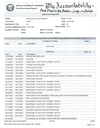
|
2023 apr 5

|
2023 mar 19
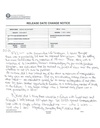
|
2023 mar 5
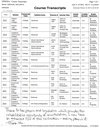
|
2023 mar 5
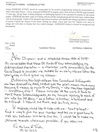
|
2023 mar 5
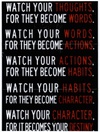
|
More... |
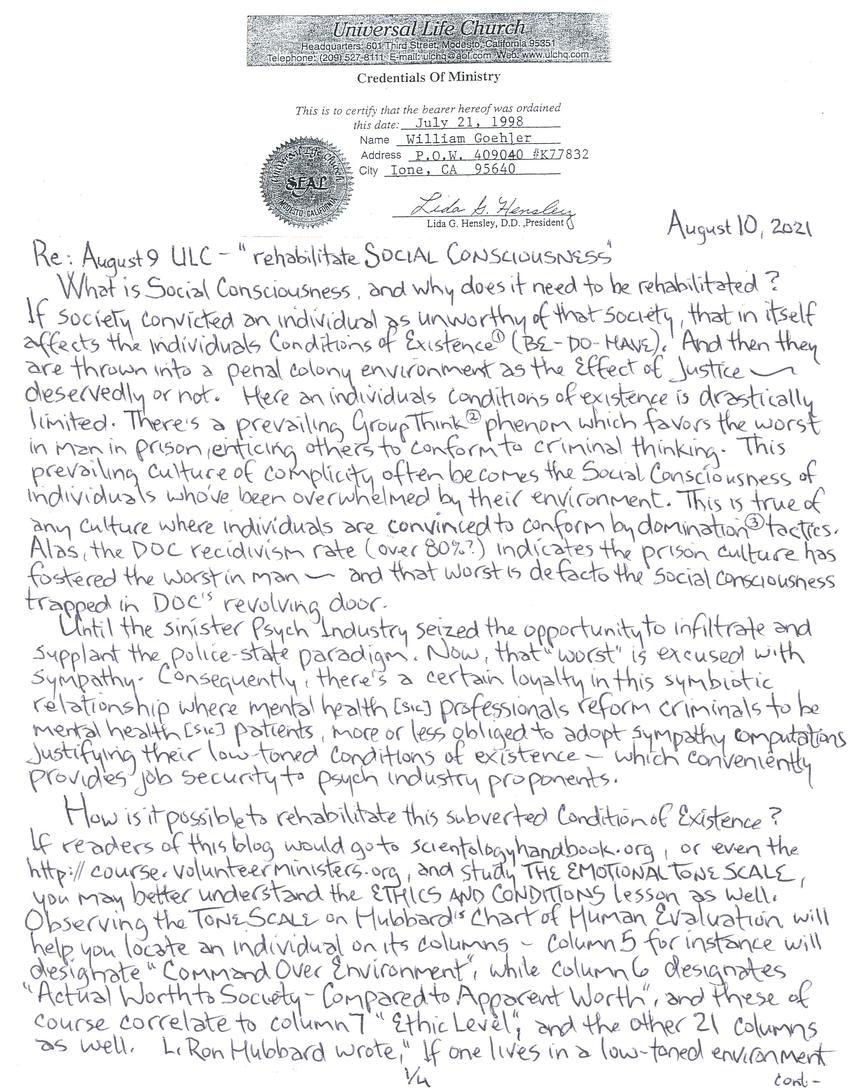
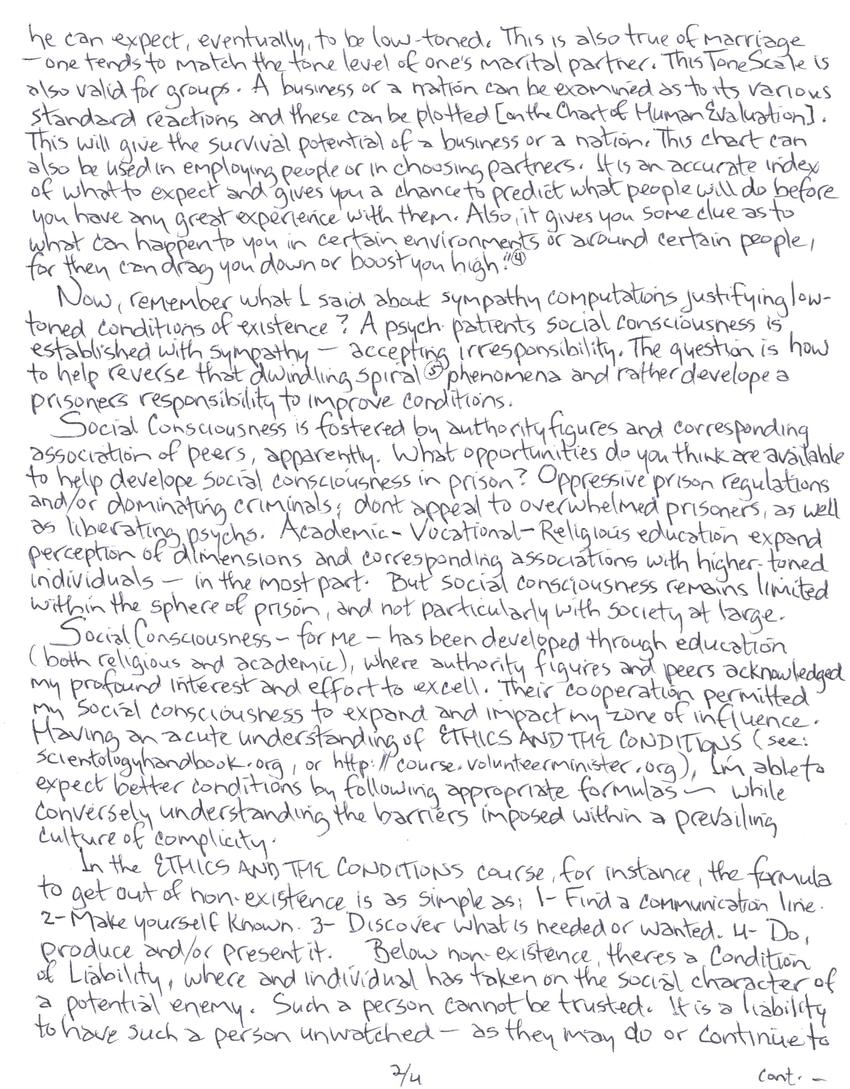
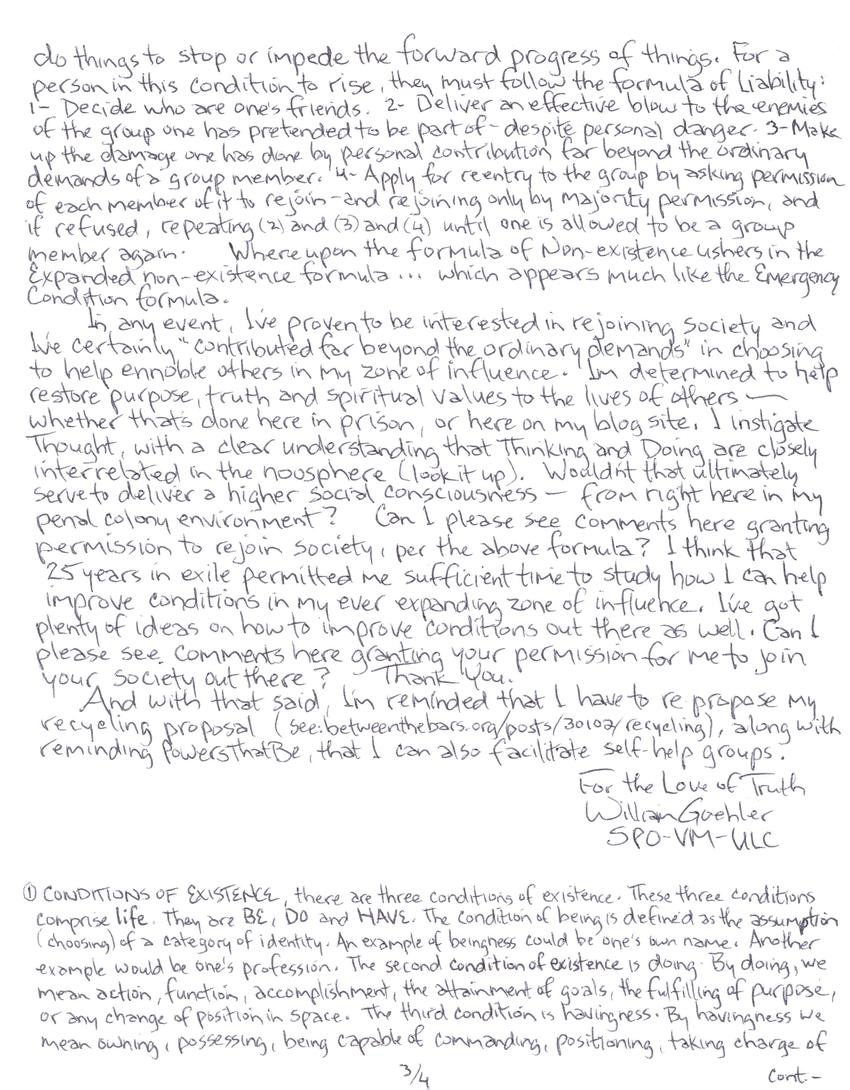
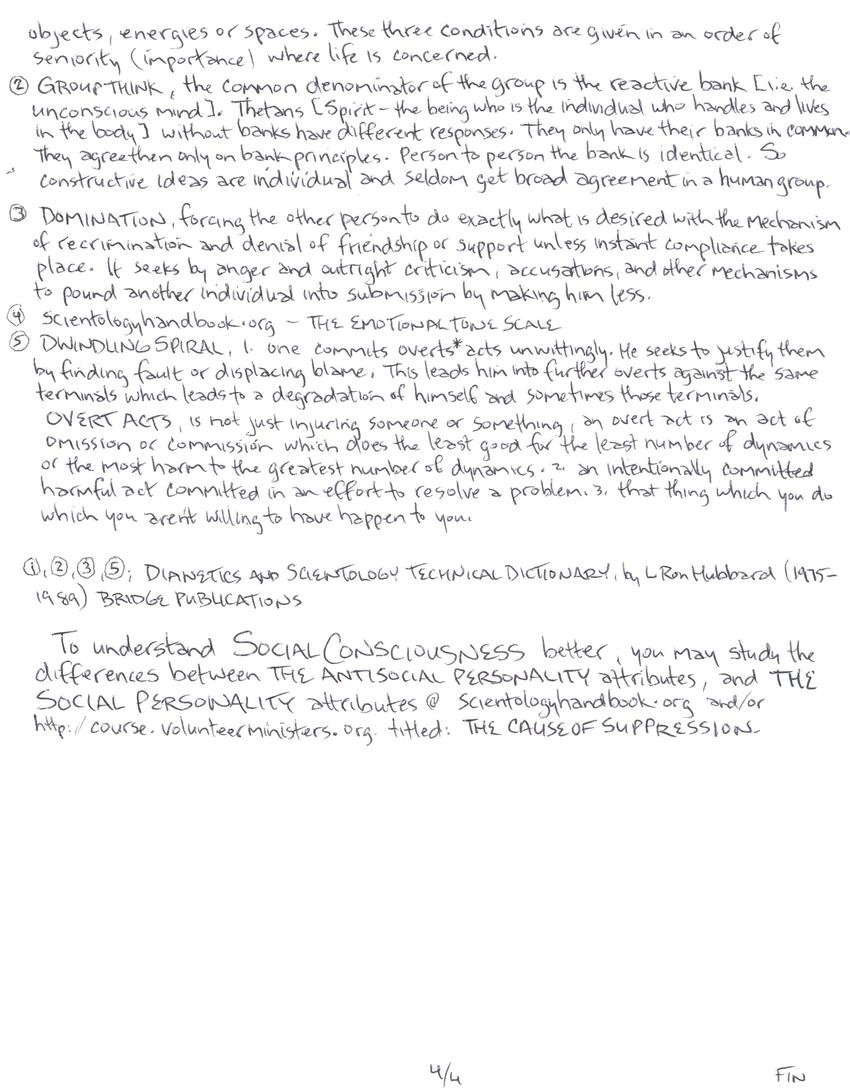
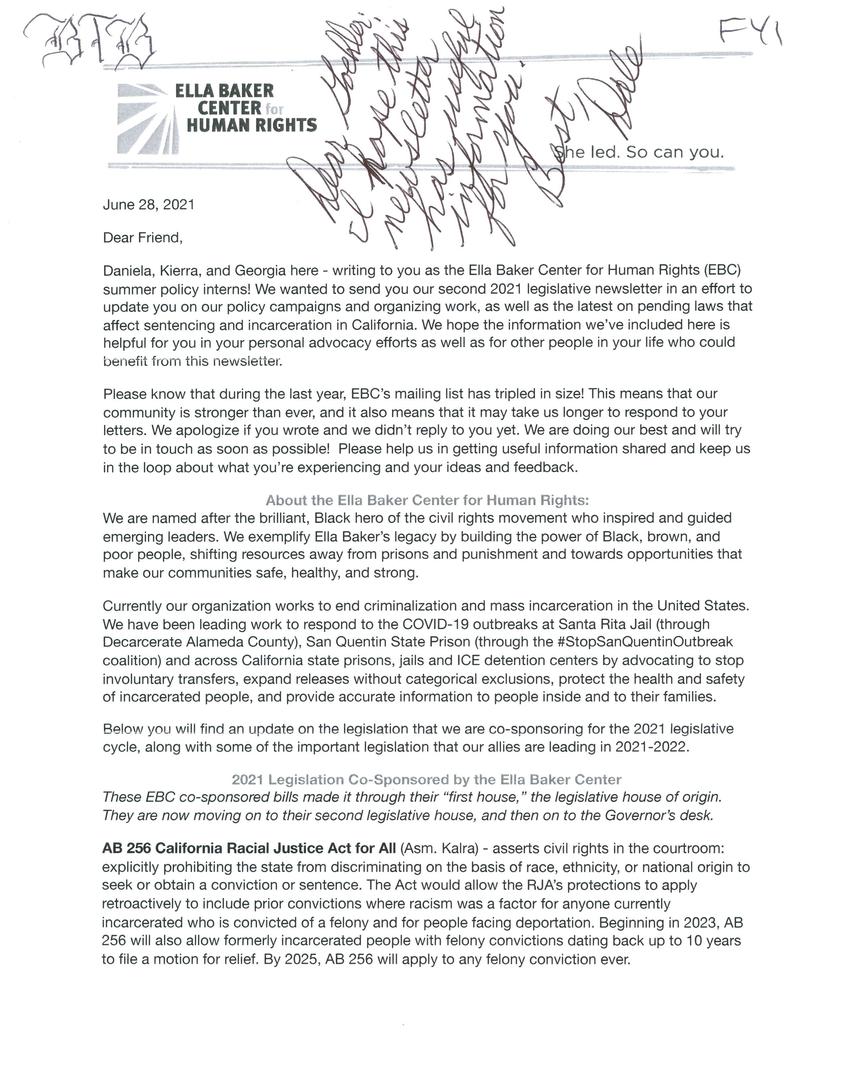
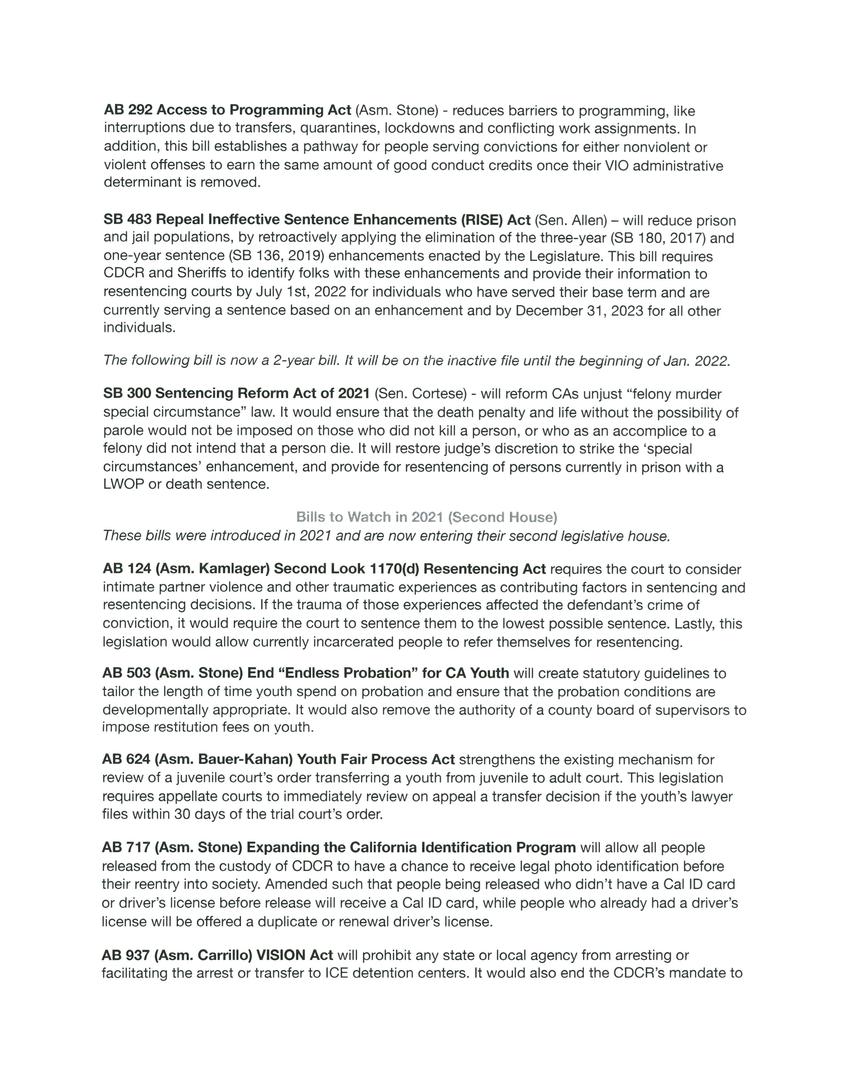

Replies (2)
This is a very strong piece. You are a talented writer and see deeply into the heart of issues and I hope you are eligible for parole. I support your right to freedom.
Peace and love,
Griffin
The Prisoners Solidarity Committee of Workers World Party believes that the criminal injustice system is racist, xenophobic, transphobic and unfair. If you are rich and white, you can continue to commit serious crimes against humanity. The rest of us suffer in prison, poverty and constant debt. We salute your efforts to win your freedom. You have served more than enough time and should be returned to the community. You are clearly tapped into the most important issues of the day and we would welcome your release from the behind the walls with open arms.
Let us know when you are collecting parole support letters. We sincerely hope that you win parole eligibility.
Yours for justice,
Judy Greenspan
Prisoners Solidarity Committee of
Workers World Party